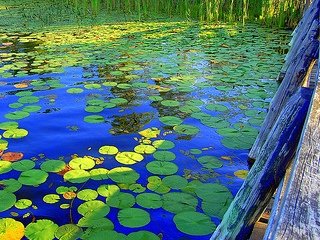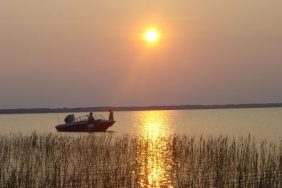
Every angler knows that the water lilies, hyacinths, and cat tails that lie scattered among our favorite lakes serve as more than just attractive portraits of nature’s beauty; they serve as aquatic neighborhoods and ambush locations for various fish species that fishermen seek. Inexperienced anglers tend to shy away from trying to fish unforgiving lily pads and thick grass mats, out of fear of losing any expensive lures, or worse: an impressive fish. Learning to fish such cover is a fundamental skill every angler should learn, as many species can be found hiding in the grass and being able to effectively pick apart vegetation to locate fish will pay off in dividends at the end of the day.
Many fish seek cover for protection, both from predators and from the heat of the sun. Predatory species seek it to conceal themselves while lying in wait to ambush prey items. Everything from the lowliest insect larvae to the apex predator in a given body of water will spend a lot of time within the weeds. In this capacity, each collection of cover is really an isolated ecosystem, with all levels of the aquatic food chain present.
There are three basic types of aquatic vegetation: floating, emerging, and submerged vegetation. Floating vegetation, affectionately known among bass anglers as “slop,” is a combination of thin algae and other plants that become mixed with lily pads and coontail. Fishing slop requires heavy line (17-lb test minimum for monofilament and fluorocarbon, 30-lb test minimum for braid) and a heavier action rod, as well as weedless lures and topwater baits. Favorites include soft plastic worms and lizards with heavy sinkers to penetrate the thick grass mats. Floating frogs and plastic toads also work wonders when fished across floating vegetation.
Emerging vegetation grows in the water with some of its top extending above the surface. Examples of such vegetation include reeds and bulrushes, which, when thickly grown, will house several organisms. Spinnerbaits and Texas-rigged worms are very effective for bass in these locations, with weedless spoons working wonders on pike early in the season. For those seeking panfish, small jigs under a slip float fished near the edges of reeds will fill your live-well with palm-sized beauties all day.
Submerged weeds, such as flats and weedlines, are a popular hangout for a large variety of fish. Many species, from walleye to trout, meander through these aquatic forests in search of food and cover. Working the edges of these weed beds with crankbaits, spinnerbaits, or swimbaits will produce strikes. Bass love jerkbaits and buzzbaits as well. Pike will explode on inline spinners and bucktail jigs retrieved quickly, just above the weeds.
Whether they create a thick blanket on the water’s surface, or sway beneath the waves, weeds continue to be a prime location for fish. Anglers well-equipped with the proper tackle, however, will have no problem dissecting such vegetation to locate their desired species. Choose the right tools for your situation and you, too, can declare yourself fearless when up against harrowing plantlife.








